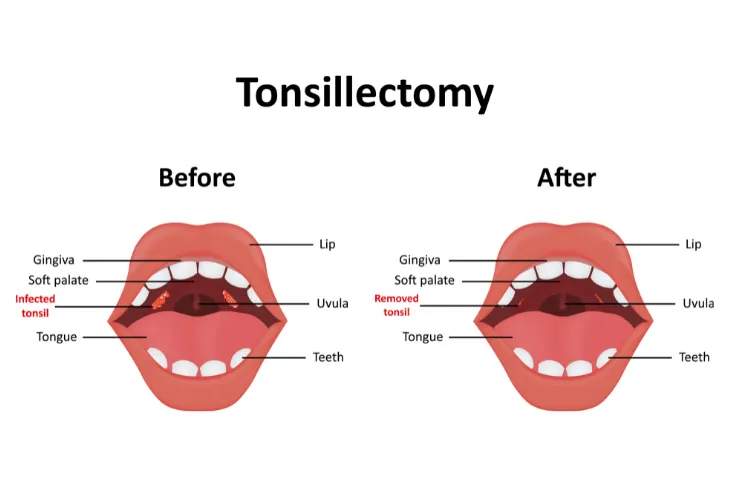- A tonsillectomy is a common procedure usually used to treat recurring throat infections or trouble breathing while asleep.
- The procedure may also be used in the treatment of cancer of the tonsils, excessive bleeding, tonsil damage, or sleep apnea.
- Cold knife dissection, cauterization, and ultrasonic vibrations are the most common methods of tonsil removal.
- Most people have no serious complications or side effects and return to school or work a week following the procedure.
If you’ve ever had swollen tonsils, you know they can be painful and irritating. Swollen tonsils can make swallowing, speaking, or eating difficult and, in rare cases, even make breathing challenging.
They often result from an illness called tonsillitis and are accompanied by other symptoms. However, this isn’t the only reason your tonsils may become enlarged. Regardless of the cause, a tonsillectomy is sometimes recommended to treat persistent tonsil problems.
Why Do We Have Tonsils?
Your tonsils are two small body parts located on either side of the back of your throat. Tonsils are part of your body’s immune system and, thanks to their location, can help prevent germs from entering the body through the nose or mouth.
Additionally, these small body parts contain many of the white blood cells responsible for killing germs. Although they’re useful, you can have your tonsils removed through a tonsillectomy procedure and still live a normal life.
What Is a Tonsillectomy?
A tonsillectomy is a common surgical procedure done to more than half a million Americans annually, most of whom are under the age of 15. During the procedure, you’ll usually be placed under general anesthesia, and then your tonsils will be surgically removed using one of three standard methods — cold knife dissection, cauterization, or ultrasonic vibration.
Although it’s a common procedure, a tonsillectomy is usually reserved as a last resort for patients with recurring tonsil-related problems. The adenoids (located between your nose and throat) are sometimes removed alongside the tonsils.
Who Usually Needs a Tonsillectomy?
A tonsillectomy is most often used for people who have recurring throat infections that present with swollen, infected tonsils. The most common of these infections is tonsillitis, and your doctor will likely only suggest a tonsillectomy if your illness comes back six or more times in a year.
Another common cause of the procedure is that your tonsils are making it challenging to breathe while sleeping. Although these reasons are most often identified in young children and teenagers, adults can and do undergo tonsillectomies.
What Are Other Reasons for the Procedure?
Although less frequent, there are several other conditions a tonsillectomy may be suggested to treat. For example, a tonsillectomy may be a crucial part of your treatment plan if you have cancer of the tonsils.
If your tonsils bleed consistently or have been severely damaged in some way, a tonsillectomy can help solve the issue and ease any ongoing or acute discomfort. Other reasons for the procedure include alleviating frequent, loud snoring or helping with a condition called sleep apnea, which causes you to stop breathing while asleep.
How Should You Prepare for a Tonsillectomy?
The most important way to prepare for a tonsillectomy is by following your doctor’s instructions exactly. You’ll be told to stop taking any anti-inflammatory medications at least 2-weeks before your surgery since these medications can increase bleeding risks.
Furthermore, certain herbs and other vitamins can also increase bleeding risks, so be sure to tell your doctor if you regularly take any supplements. You’ll also be told to fast after midnight before your procedure.
 novak.elcic / Shutterstock
novak.elcic / ShutterstockProcedure Option: Cold Knife Dissection
If you’re told your tonsils are going to be removed using cold knife dissection, this means your surgeon will cut them out using a scalpel. You’ll be placed under general anesthesia during the procedure, which means you’ll be asleep and won’t feel anything.
Your surgeon may use stitches at the removal site to help with the healing process. Generally, these will dissolve on their own and don’t need to be physically removed by the doctor.
Procedure Option: Cauterization
Cauterization is another popular tonsil removal option your surgeon may use for your procedure. Cauterization involves burning away the tissues instead of cutting them out. You shouldn’t need stitches following a cauterization tonsillectomy, but you will still be under general anesthesia.
The procedure should only take about half an hour but may take a little longer if there are complications or if you’re also having your adenoids removed. Your surgeon will let you know what to expect ahead of time.
Procedure Option: Ultrasonic Vibration
Ultrasonic vibration is the least common tonsillectomy option but is used more frequently today than in years past. This procedure involves using a tool called a harmonic blade to both remove the tonsils and cause the blood to coagulate, which is critical to the healing process.
The harmonic blade operates using a specific frequency that produces low heat. Like with other procedure options, you’ll be placed under general anesthesia. However, you shouldn’t need stitches following ultrasonic vibration removal.
What Risks Are Associated With a Tonsillectomy?
Most people have no serious complications or side effects from a tonsillectomy because it’s a very common procedure that is generally assumed to be safe. However, it is still a surgical procedure, and all surgeries come with some risks.
The most common risks are swelling and bleeding at the surgical site. Infection is also possible, which can cause its own problems and is often treated with antibiotics. Reaction to the anesthesia used is also possible, which can, in rare instances, be life-threatening.
What Does the Recovery Process Look Like?
You’ll likely be kept at the hospital for a few hours following your procedure and discharged the same day. Someone will need to drive you home because you won’t be allowed to do so after general anesthesia. You’ll also need to rest in bed as much as possible for a few days.
A small amount of swelling and bleeding at the site is expected, as is a moderate amount of pain. Your doctor may prescribe pain medications and an antibiotic following your tonsillectomy. You should take all medications exactly as prescribed.
How Long Is Recovery?
Most people return to work or school about a week after their tonsillectomy. However, some people will naturally recover a little slower. For example, adults may take slightly longer to recover than children.
For a few days directly following your tonsillectomy, you should plan to stay in bed to allow your body to heal. It’s helpful if you can have a spouse, friend, or relative stay with you for a few days to help. After the anesthesia, you may feel tired or out of it for a few hours.
 Shutterstock/fizkes
Shutterstock/fizkesHow Can You Speed Recovery?
Getting enough rest and following your doctor’s instructions are the best way to a speedy recovery after a tonsillectomy. Drink plenty of fluids, but avoid anything too hot or too cold, as that may irritate your throat. However, eating popsicles or sucking on ice cubes may help ease discomfort.
If possible, plan to take a whole week off work or school. After a few days, try introducing soft foods such as jello, pudding, and thin soups to your diet to help give your body the energy it needs for recovery.













